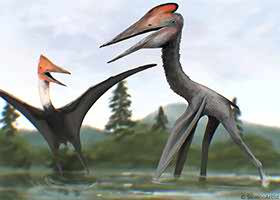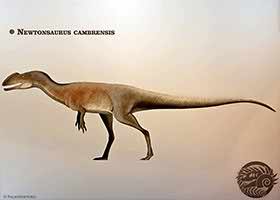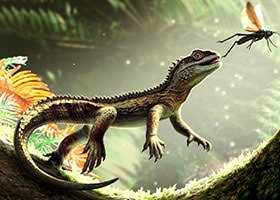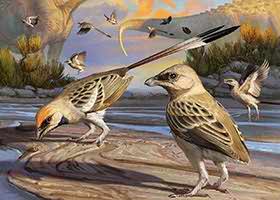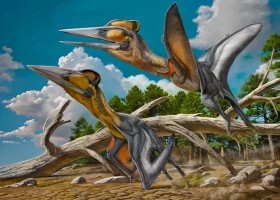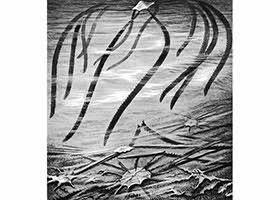
The evolution and transition to land of tetrapods, which began in the Middle Devonian period, became one of the most important events in the evolution of vertebrates. However, the discovery of very early tetrapod tracks turned out to be older than the fossils of their supposed ancestors—elpistostegids. This challenges the existing understanding of the timeline of evolution. This new evidence suggests that tetrapods may have evolved earlier than previously thought, forcing scientists to reconsider their theories about the transition from aquatic to terrestrial life.
Early tetrapod tracks are present in both Europe and Australia. Some of these controversial findings still provoke many debates. Studying tetrapod tracks, in general, is difficult to date and identify. In general, it is difficult to date and identify. They are evidence of the terrestrial nature of four-legged vertebrates in those layers that precede the finds of the earliest—and obviously still aquatic—fossilized remains of tetrapods.

Tetrapodomorphs and the Origin of Tetrapods
Tetrapodomorphs are extremely poorly represented in the Early Devonian. Only two genera are known—Tungsenia from the Pragian and Kenichthys from the Emsian, both from Yunnan, China. These earliest representatives of the group were small fish with cosmine scales. They were probably generally similar to the Middle Devonian “osteolepids” such as Osteolepis and Thursius. But they possessed some unique primitive features that show they occupy a phylogenetically basal position among tetrapodomorphs.
Timing of the Emergence of Tetrapods
Currently, the timing of the transition from fish to tetrapods is uncertain, although it clearly predates the early Eifelian. The Early Devonian is the most likely period. But we should not overlook the possibility of earlier, though questionable, tetrapod ichnofossils like the Silurian track from Glenisla.

The stem group of tetrapodomorphs most likely originated in the Lochkovian, on the South China microcontinent. By the beginning of the Eifelian, approximately 25 million years later, elpistostegids and primitive tetrapods had appeared. Unlike the earliest representatives of the stem group, elpistostegids and tetrapods were fairly large animals, usually 1 meter or more in length. Their evolution involved adaptations for substrate locomotion, body weight support, and aerial vision. Their activity occurred in shallow waters and along the shoreline.

Most evidence suggests that tetrapods originated in Euramerica (Laurussia). However, tetrapodomorph fish showed up much later in the fossil record here. This occurred only at the beginning of the Eifelian, shortly before the tracks appeared in Zachełmie. These fish are small, cosmine-covered osteolepids.
Timeline of traces and fossils
The origin of tetrapods, elpistostegids, tristichopterids, and rhizodonts should be dated to the earliest Eifelian or even earlier. This seems like a realistic proposal, considering it allows a timeframe of approximately 24 million years from the emergence of the common group of tetrapods in the Lochkovian age. However, there is currently no fossil evidence to support this assumption.

The earliest definitively established fossils of tetrapod bodies come from late Devonian deposits, which are approximately 14 million years younger than the early tetrapod tracks from Zachełmie. And the earliest known elpistostegid, Panderichthys, is contemporary with the Valentia Island tracks and thus about 5 million years younger than Zachełmie. This means that the split between elpistostegids and tetrapods must have occurred before the formation of the layers bearing the Zachełmie tracks.
Indirect evidence supporting this claim is the fragmentary taxon Livoniana. It is a contemporary of Panderichthys but seems more advanced than any known elpistostegid. It may represent a very primitive tetrapod or a transitional form to the earliest tetrapods.
Early Tetrapod Tracks and the Origin of Tetrapods

In the found fossils, tetrapods are preceded by fish-like “osteolepiforms” such as Eusthenopteron and Gogonasus and transitional elpistostegids such as Elpistostege, Panderichthys, and Tiktaalik, which still lack a sacrum and have only paired fins. The earliest body fossils of tetrapods date back to the late Devonian period (late Frasnian stage).

It is noteworthy that both the earliest (Zachełmie) and the second earliest (Valentia Island, Ireland; late Middle Devonian (Givetian)) tetrapods in the fossil record are represented by footprints.

Tetrapods represented by footprints appear in the fossil record long before elpistostegids. The Zachełmie tracks are ten million years older than Panderichthys, but even the younger and less controversial Valentia Slate tracks, which include a series of long lateral sequences made in shallow water or on land, are slightly older than Panderichthys. Remember that Panderichthys is usually considered the least crownward elpistostegid. The more tetrapod-like Tiktaalik has an early Frasnian age, probably 2–4 million years later than Panderichthys.

Both scientific literature and numerous popular presentations have promoted Tiktaalik as a direct ancestor of tetrapods. However, the evidence from the footprints challenges this notion. Instead, Tiktaalik and Elpistostege appear to be late survivors of an elpistostegid radiation.
Revisiting the Evolutionary Role of Elpistostegids
Elpistostegids retained adaptations for swimming in the water column, such as paired fins, straight elbows, and backward-oriented pelvic fins. Both elpistostegids and early tetrapods remained closely tied to water, as evidenced by the retention of lateral-line canals. Both groups were predators.
The most puzzling aspect of elpistostegids is their complete absence in the fossil record during the Eifelian and early Givetian periods. The Baltic mega-delta already existed in the early Middle Devonian. Researchers have thoroughly studied the fossil assemblages of its strata, but have found no trace of elpistostegids. Presumably, they were somewhere else, either ecologically or biogeographically.
The discovery of Middle Devonian early tetrapod tracks predates the earliest body fossils of both elpistostegids and tetrapods themselves. This finding challenges the hypothesis that tetrapods evolved from elpistostegids during the Frasnian in a predominantly aquatic environment.
Coexistence of Elpistostegids and Tetrapods
In the early Late Devonian (Frasnian age), elpistostegids disappeared from river and delta environments, and were replaced in these environments by tetrapods.

Scientists previously viewed the shift from elpistostegids to tetrapods in the fossil record in the mid-to-late Frasnian period as an evolutionary transition, where tetrapods evolved from elpistostegids1. Elpistostegids were considered a short-lived “transitional stage” between fish morphotypes and tetrapods. In reality, elpistostegids simply went extinct, and tetrapods took their place, occupying these habitats. However, the details of the replacement process are still unclear.
In fact, early tetrapod tracks indicate that they and elpistostegids coexisted, at least from the early Eifelian to the mid-Frasnian, that is, for approximately 10–14 million years. This means that the morphology of elpistostegids represented not a brief transitional stage, but an independent, stable adaptive lineage. This is reminiscent of the prolonged coexistence of non-flying, but feathered and “winged” theropod dinosaurs with flying stem-group birds in the Mesozoic.
Evidence disputes elpistostegids as tetrapod ancestors

In tetrapodomorph fishes such as Panderichthys and Tiktaalik, the powerful pectoral fins are significantly larger than the pelvic fins. They are completely unlike the pelvic limbs of tetrapods (e.g., Acanthostega). Panderichthys shows a pectoral fin skeleton with features typical of tetrapods, while the pelvic fins retain a more fish-like structure. Thus, there is a clear discrepancy between the locomotor apparatus of terrestrial tetrapods, driven by the hind limbs, and the locomotor apparatus of their presumed closest relatives, driven by the forelimbs. Based on the footprints, this evolutionary gap was already bridged in the Middle Devonian.
Since these early tetrapod tracks are older than the earliest elpistostegid fossils, it means that elpistostegids, like the famous Tiktaalik, were not the ancestors of tetrapods. On the contrary, the direct fish ancestors of tetrapods are currently unknown.
Indeed, currently known fossils of “stem tetrapods” and their putative closest relatives, tetrapodomorph fishes, most likely do not represent the main lineage of tetrapod evolution. They are apparently a group convergent in many morphological features with tetrapods.
The tracks found in the Holy Cross Mountains (Poland) belong to tetrapods, but the phylogenetic position of elpistostegids (including Tiktaalik) remains unchanged. As a result, at least six long ghost lines appear, separating the track makers of Zachełmie from various species of elpistostegids and ichthyostegids.2
“Ghost lines” are periods when animals must have existed, but no fossils currently confirm their presence.
Early Tetrapod Tracks

By tetrapods, we mean vertebrates with limbs and digits, not paired fins. Limbs with digits first evolved in tetrapods for use in water and were only later adapted for use on land (Coates and Clack, 1990; Gould, 1991). The anatomy of the feet of early tetrapods is known for only three taxa—Acanthostega, Ichthyostega, and Tulerpeton.

Researchers found that all genuine Devonian tetrapod tracks formed in non-marine environments. This means that they do not support a marginal marine origin of tetrapods. They indicate a lateral sequence of walking and movement using pelvic limbs, fully terrestrial (subaerial) locomotion in a freshwater environment, at least for some Devonian tetrapods.
The most supported opinion is that the transition from fins to limbs occurred in an aquatic environment. This means Devonian tetrapods were likely mostly aquatic. Ichthyostega and Acanthostega had relatively inflexible paddles, which would hardly have left the types of Devonian tracks attributed to tetrapods.
Most Devonian tetrapods hardly walked on land, leading an aquatic lifestyle. This is why footprints of Devonian tetrapods are so rare.
Pattern of Tetrapod Locomotion
The genuine tracks of Devonian tetrapods indicate an alternating pattern of movement of creatures with limb support, where the hind legs are larger than the front ones.
In contrast, the walking of arthropods produces tracks that represent a set of symmetrical marks (footprints) that define a linear or curved track. It may have a median imprint (usually a telson drag mark) or lack one.

Tetrapods left characteristic alternating tracks. However, theoretically, they could create symmetrical tracks if they moved like the modern mudskipper, “supporting” themselves on their pectoral limbs (Pierce et al., 2012, 2013; Edwards, 1977).
Early tetrapod tracks from Valentia Island, Tarbat Ness, and Genoa River demonstrate a lateral sequence of walking, where the legs move diagonally, the left front together with the right rear, and so on, like modern salamanders. We can also see one short example of this walking method preserved in Zachełmie.

The creatures that left the tracks were capable of effectively moving on land, which is consistent with the limb morphology recorded from the tracks. The body fossils of these Devonian tetrapods are still awaiting discovery.
There is no consensus on whether Devonian tetrapods could hold their bodies above the ground while walking (Ahlberg et al., 2005; Carroll and Holmes, 2007) or moved on land by crawling, dragging their belly (Roček and Rage, 1994).
Indeed, late Paleozoic amphibian tracks contain relatively few examples of body drag marks (e.g., Haubold, 1971; Voigt, 2005; Lucas et al., 2010). Thus, a median drag mark is not diagnostic for Devonian tetrapod tracks, although it may be present.


Paleozoic amphibian tracks may or may not have a tail or belly drag mark.
The tracks indicate that in the Middle Devonian, tetrapods appeared with larger hind limbs than forelimbs. This raises doubts about whether the known Devonian body fossils of tetrapods and their presumed ancestors, the tetrapodomorph fishes, which conversely have larger forelimbs than hind limbs, represent the main line of tetrapod origin and evolution. Thus, the ichnology of Devonian tetrapod footprints requires a rethinking of existing ideas about the origin and early evolution of tetrapods.
Habitat
In the Devonian period and even in later epochs, many tetrapods demonstrated a constant dependence on the aquatic environment, which limited their ability to spend extended periods on land. They were capable of only relatively short terrestrial excursions.

Since reliable Devonian tetrapod tracks come from non-marine deposits, they do not support the origin of tetrapods from marginal marine environments, as previously suggested.
It is important to note that well-preserved tetrapod tracks can also form underwater (P.J. Manning, 1996). Moreover, tetrapod tracks often appear in geological facies where their body fossils are rarely or never present.
Elpistostegids were present in the lower reaches of large rivers, deltas, and estuaries from the late Givetian period to the mid-Frasnian. Judging by the tracks, tetrapods inhabited the upper parts of river streams and around shallow water bodies on coastal plains. These conditions did not favor the preservation of body fossils.
This means that environmental conditions suitable for preserving tracks may not favor the preservation of body fossils, or that tetrapods inhabited regions where their remains were less likely to fossilize.

(a) Middle Devonian–Early Frasnian: elpistostegids occupy the lower parts of permanent river systems, while tetrapods are present in the upper parts of river basins, in sabkhas, and in coastal lakes. The topmost elpistostegid represents Tiktaalik, the two lower ones are Panderichthys and Elpistostege. Tetrapods from top to bottom represent Valentia Island, Tarbat Ness, and Zachełmie. (b) Late Frasnian and Famennian periods: elpistostegids have disappeared, and all habitats are occupied by tetrapods.
Tetrapods represent, from top to bottom, the Britta Dal Formation, Genoa River, Catskill Formation, Sosnogorsk Formation (and possibly Andreyevka-2) and tetrapod localities in the Main Devonian Field (Velna Ala, Pavari, Ketleri). Some of these localities contain several tetrapod species.
Both elpistostegids and tetrapods appeared no later than the early Middle Devonian. During the Middle and Late Devonian, tetrapods settled in relatively dry and often seasonal environments with rivers or lakes, from coastal plains to the upper parts of river basins. Elpistostegids inhabited the tidal zone of deltas and estuaries, as well as the lower reaches of rivers, in the late Givetian and early Frasnian. They are known only from Laurussia, while tetrapods also lived in Gondwana.
Tetrapods from Zachełmie and the Genoa River appear to have made tracks in shallow water. But some of the tracks from Valentia Island are terrestrial, as are the tracks from Tarbat Ness. In all cases, the tracks have fairly deep impressions, indicating that even in subaqueous tracks, the body was not fully supported by water. On Valentia Island and in Tarbat Ness, we have direct evidence that tetrapods moved on land.
Researchers tested 51 ancient fossilized bones of tetrapods and lobe-finned fish to determine their habitat. The team examined sulfur and oxygen isotopes. They found that fresh water had an effect on these creatures. The available data suggests that tetrapods could live part of the time in seawater and part of the time in fresh water. Such places today include estuaries, river mouths, and river deltas. Researchers note that the ability to live in waters with varying salinity would have given tetrapods an advantage. They could survive in both types of water and sometimes on land.3
- Per E. Ahlberg, 2018. Follow the footprints and mind the gaps: a new look at the origin of tetrapods. ↩︎
- Niedzwiedzki et al., 2010. Tetrapod Trackways from the Early Middle Devonian Period of Poland ↩︎
- Jean Goedert et al., 2018. Euryhaline ecology of early tetrapods revealed by stable isotopes, Nature. ↩︎












